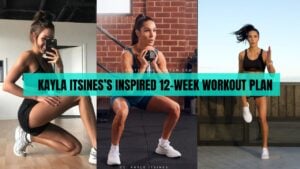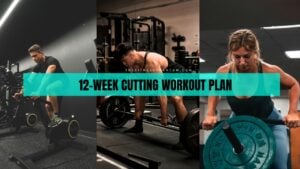The deadlift is unarguably one of the most effective resistance exercises. It simultaneously works on several muscles, including the hamstring, glutes, quads, adductors, back, core, and the numerous synergist muscles in the upper body, and enhances strength and functional fitness.
From Conventional and Sumo to Romanian and Snatch Grip, you can perform various deadlift variations to bolster every muscle throughout the body, level up your strength, and help build a firm and aesthetic body.
In this article, I’ll discuss the deadlift exercise, including correct form, variations, benefits, and alternatives.
The Deadlift Form
Deadlifts are an advanced-level exercise that requires proper techniques and great strength. Many people fear doing deadlifts because of injuries. However, doing them with a proper technique can increase the overall strength of the body.
Here are some important tips you must implement while performing the deadlift and its variations.1 The Deadlift and Its Application to Overall Performance – National Strength and Conditioning Association (NSCA)
- To lift the weight, slightly bend your knees and push your hips back (but do not arch your back).
- Your eyes need to be looking slightly upward because it allows your back to stay in a neutral position throughout the movement. Doing so also allows your hips and leg extensors to work at the same time.
- Keep the barbell close to your body during the entire movement because it allows your legs to generate more power while lifting. Additionally, holding the bar away from the body increases the risk of injury.
- Before lifting the bar, take a deep breath.
- Keep your core tight during the whole lift.
- Your muscles of the back, especially the lats, need to fully activate at the time of lifting the bar.
- Try to push your knees apart, as it can help your glutes remain active during the entire lift.
When it comes to the deadlift, form is everything. Doing a deadlift with proper form is essential for a safe and effective workout.
Whether you are a beginner or an intermediate, if you perform a deadlift with incorrect form, you’ll likely get injured, especially with back injuries or pain. That is why it is essential to know the correct deadlift form and technique.
7 Best Deadlift Variations for Strength and Muscle
1. Conventional Deadlift

The conventional deadlift targets all the responsible lower body muscles. It engages all the muscles at once, which provides many benefits, from improving body postures and grip strength to increasing whole-body lifting strength.
The deadlift also acts as a fat burner as it burns more calories than any other compound exercise and may reduce body fat without losing actual muscles.
Steps to Do a Conventional Deadlift
- Place a bar on the floor along with the desired weight.
- Stand straight with your feet hip-width apart and shin close to the bar.
- Slightly bend your knees and push your hips back just enough to reach and grab the bar.
- Hold the bar firmly with both hands in a hook grip. Adjust the width between your hands so the arms stay just outside the knees.
- Keep your arms straight with your palms facing you. And your hands must be equally far from the ends of the barbell. That’s the set-up.
- Take a long breath, keep your abdominal muscles tight, push through your legs, and lift the bar with your full strength. And remember activating your lats first.
- Keep your spine in a neutral position and raise your hips and shoulders at the same time and range.
If you are a beginner or if you want to lift more weight, you should better use a belt because the belt can protect your back and waist from injuries.
2. Romanian Deadlift
The Romanian deadlifts enhance muscle strength, especially of the lower body, erector spine, and core. It also improves posture and grip strength and prevents injuries caused by lower back stress.
The RDL also teaches the proper movement of standing hip flexion and extension, which is crucial for performing squats safely and effectively.
Steps to Perform a Romanian Deadlift
- Hold a barbell along with your desired weight in front of your thighs with an overhand grip, hands slightly wider than shoulder-width apart, and palms facing the body.
- Maintain a slight bend in the knees and keep your feet hip-width apart.
- Keep your chest up, slightly lower your shoulder blades down toward the back, and maintain a neutral spine position. That’s your starting position.
- Brace your core, inhale, and start lowering the weight as low as possible toward the floor with a slight bend in your knees. Do not bend or round your back during the entire movement.
- Hold for a second, then push through your heels, press the hips forward, and slowly lift the weight to the starting position. That’s one rep!
- Perform as many reps and sets as you can.
- Squeeze your glutes and hamstrings until you completely stand up.
- Keep your back straight and the barbell close to the body throughout the movement.
3. Sumo Deadlift

The sumo deadlift is highly effective for hips and glutes. It improves overall body stability and body postures.
It puts less stress on the erector spine, which prevents you from any injuries. Not only this, but it is also great for core muscle strength and stability.
Steps to Perform a Sumo Deadlift
- Stand with your feet slightly wider than shoulder-width apart, and turn your feet slightly out to the sides.
- Externally rotate your hips and Hold a barbell along with your desired weight in front of your thighs with an overhand grip, palms facing the body.
- Brace your core and start lowering the weight (your elbows between the knees) toward the floor by bending your knees.
- Hold for a second or two and then return to the starting position.
- Keep your back straight during the movement.
- Perform as many reps and sets as you can.
4. Hex-Bar Or Trap Bar Deadlift
The hex bar deadlift is comparatively easier and safer than any other form of deadlift. It puts less stress on the lower back, which is important for people with back issues.
Hence, it is safer for the back and prevents any injuries. A trap bar deadlift is a versatile form of deadlift that allows you to lift more weight and perform extra reps and sets.
Steps to Do a Trap Bar Deadlift
- Stand straight with your feet hip-width apart. Push your hips back, bend your knees, and lower yourself to grab the trap bar’s handles.
- Keep your chest up and shoulder blades down so that you can lift the weight powerfully.
- Raise your hips and shoulders at the same range while maintaining a straight back.
- Take a long breath and lift the bar with full strength.
- Hold for a couple of seconds, then slowly lower the weight back on the floor. That’s one rep!
- Perform as many reps and sets as you can.
- Keep your core tight during the whole lift.
5. Wide/Snatch Grip Deadlift
The snatch grip deadlift targets different muscles at once, like other variations of the deadlift, but it is a bit advanced and challenging movement.
The wide-grip deadlift targets your traps, upper back, hamstrings, and glutes. A wider grip deadlift not only targets your lower body but also develops your upper and lower back.
Many powerlifters use this movement to increase their lifting capacity, and they build stronger back and legs.
Steps to Perform a Snatch Grip Deadlift:
- Put the desired weight in the bar and place it on the floor.
- Stand straight with your feet hip-width apart and shin close to the bar.
- Slightly bend your knees and push your hips back just enough to reach and grab the bar.
- Hold the bar firmly with both hands with a hook grip. And make sure your hands are a couple of inches wider than shoulder-width apart. That’s the set-up.
- Inhale deeply, keep your core tight, and push your heels into the floor to lift the bar with your full strength.
- Maintaining your spine in a neutral position, raise your hips and shoulders at the same time.
- Perform as many reps and sets as you can.
6. Stiffed Leg Deadlift
The Stiff-Legged Deadlift is a highly effective exercise that simultaneously works for various muscle groups. It strengthens the upper and lower back, deltoids, quads, hamstrings, and glutes.
It also improves bad posture and enhances endurability. One of the stiff leg deadlift’s main benefits is that it equally works on the hips, quads, and hamstrings.
This provides explosive power to your leg for jumping, leg press, and inclines running.
Steps to do Stiffed Leg Deadlift:
- Hold a barbell along with the desired weight in front of your thighs with an overhand grip, palms facing the body.
- Start lowering the weight as low as possible toward the floor while keeping your back straight.
- Hold for a couple of seconds, then slowly lift the weight to the starting position. That’s one rep!
- Squeeze your glutes and hamstrings until you completely stand up.
- Perform as many reps and sets as you can.
7. Rack Pull Deadlift
The major target muscles of the rack pull are your lower back. However, this movement also works on your upper back, hamstrings, and glutes.
The rack pull improves grip strength, helping you perform other forms of deadlifting.
If you’re a beginner, then you can start deadlifting this movement because it is safer and easier than other types of deadlifts.
Steps to Perform a Rack Pull Deadlift
- Start by setting up the height of your rack and then stand straight with your feet hip-width apart
- Bend your knees and hips just enough to reach and grab onto the bar.
- Grip the bar a bit wider than your hip-width
- Keep your arms extended and your back straight during the movement.
- Squeeze your glutes and hamstrings until you completely stand up.
- Your hand must be equally far from the ends of the barbell.
- Raise your hips and shoulders at the same range while maintaining a straight back. That’s one rep!
- Keep your core tight during the whole lift.
- Perform as many reps and sets as you can.
3 Best Deadlift Alternatives to Bolster Your Legs
If you do not want to do a deadlift because you feel it’s tough or it makes you feel discomfort, then no worry. You can still try different deadlift alternatives. These alternatives may not be as effective as the real deadlifts, but they can help you build strength and muscles.
Here are the 3 exercises you can do as alternatives to the deadlift workout.
1. Bulgarian Split Squat
- Stand in the hip-width stance in front of a bench (2 feet away).
- Place your rear feet firmly on the bench and the front one on the floor, and maintain a 10-12 inches distance between them.
- Keep your core engage, back flat, and lower your rear foot toward the ground as low as possible.
- Hold for a moment, and then push your front foot heel into the floor and return to the starting position.
- Repeat as many times as you like.
- You can use a dumbbell and a barbell for resistance.
- For more information and a specific guide, you can see this article on the Very Well Fit site.
2. Barbell Hip Thrust
- Put your upper back on a flat bench with your knees bent and feet firmly planted on the floor. Keep your feet hip-width apart.
- Bend your elbows and hold your arms on the bench with your fingertips on your head. This is your starting position.
- Now, push into the floor with your heels to thrust your hips until your thighs are parallel to the ground.
- Squeeze your glutes at the top for a couple of seconds and then return to the starting position.
- For resistance, you can use a barbell.
3. Cable Pull-Through
- Anchor the rope to the cable pulley machine in the lower section.
- Set the desired weight according to your strength.
- Stand shoulder-width in front of the cable pulley machine (two feet away) with your face facing away.
- Grab the rope firmly with your hands so your palms are facing each other.
- Slightly bend your knees, push your hips back, and maintain a neutral spine posture.
- Pull the weight upward until you feel a good contraction in your hamstring and gluteus.
- Hold for a couple of seconds and then return to the starting position.
- Repeat for the required number of repetitions.
Wrapping it Up
Conventional, Sumo, Romanian, Snatch Grip, Hex Bar, Rack Pull, and Stiff Leg are the seven deadlift variations you can do to stimulate your strength and muscle mass and improve your functional fitness.
If you’re a beginner, the best deadlifts you can start with are the rack pull and the trap or hex bar deadlift. Once you’re experienced in deadlifting, you can move on to another type, such as Romanian and sumo, which are most effective for overall strength.
Doing the different types of deadlifts will maximize your strength and help you build a sizable body.
For safety reasons, you can use a waist belt. A weight belt can help create tension through the muscles to stabilize the spine and may protect your back and lumbar spine from any unwanted injuries or pain when you lift more weight. However, you can perform the deadlift without a belt with lighter weights.
Sometimes, it is normal to feel some back pain when you first start deadlifting. However, if your lower back pain persists even after deadlifting many times, it is recommended that you stop doing it.
References
- 1The Deadlift and Its Application to Overall Performance – National Strength and Conditioning Association (NSCA)






